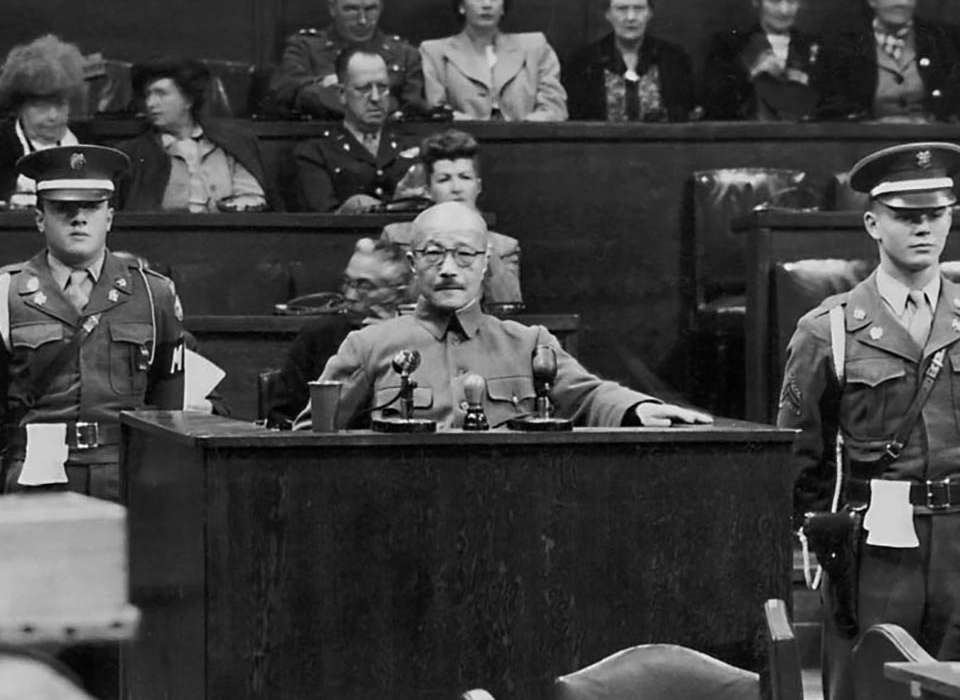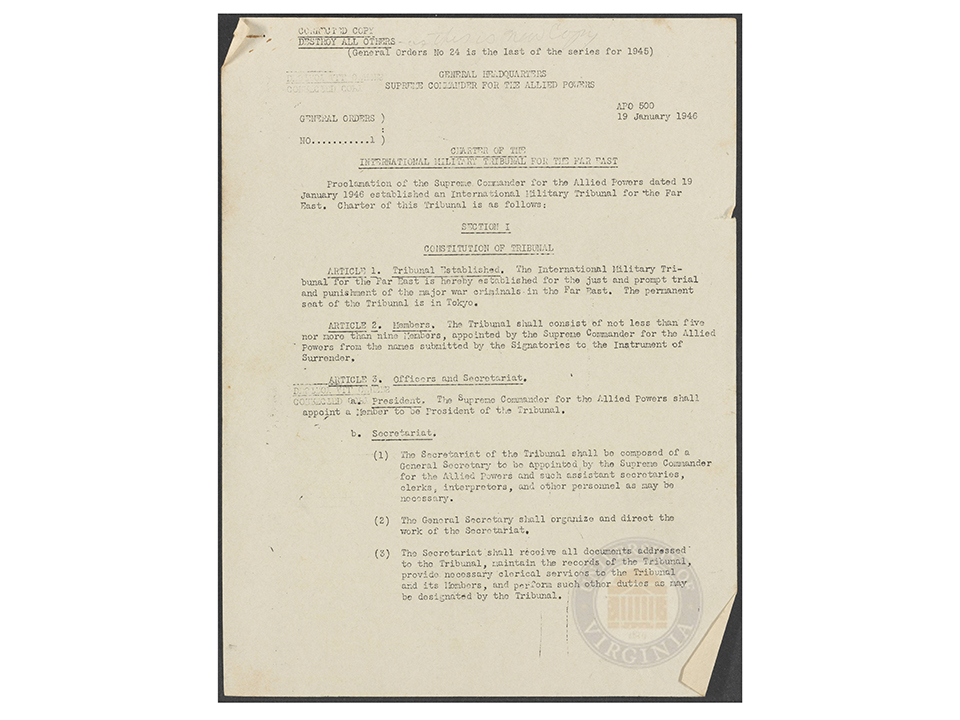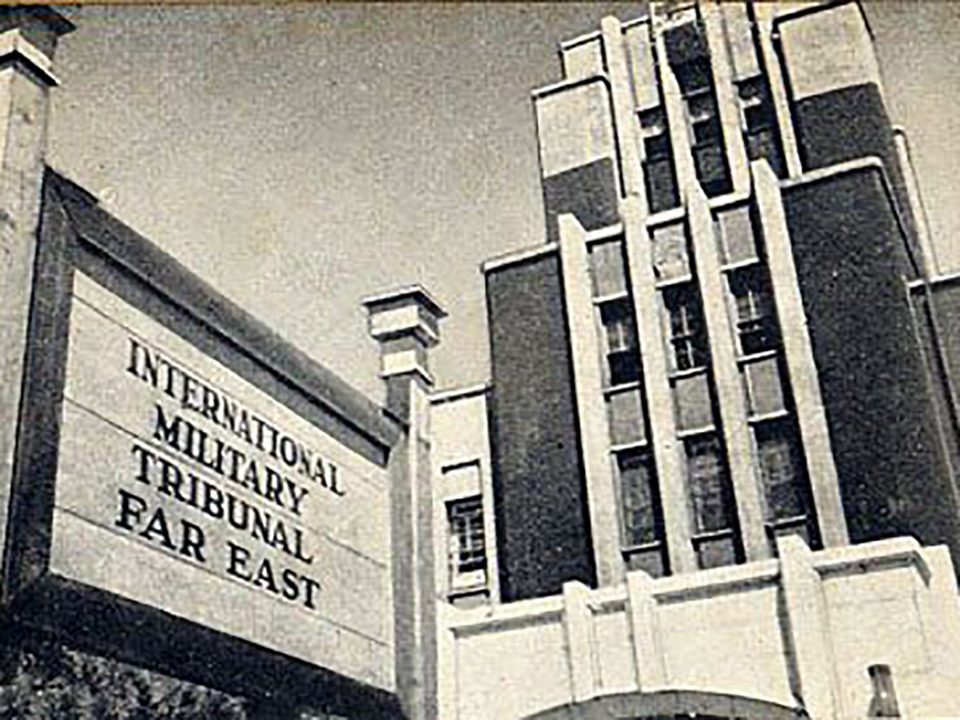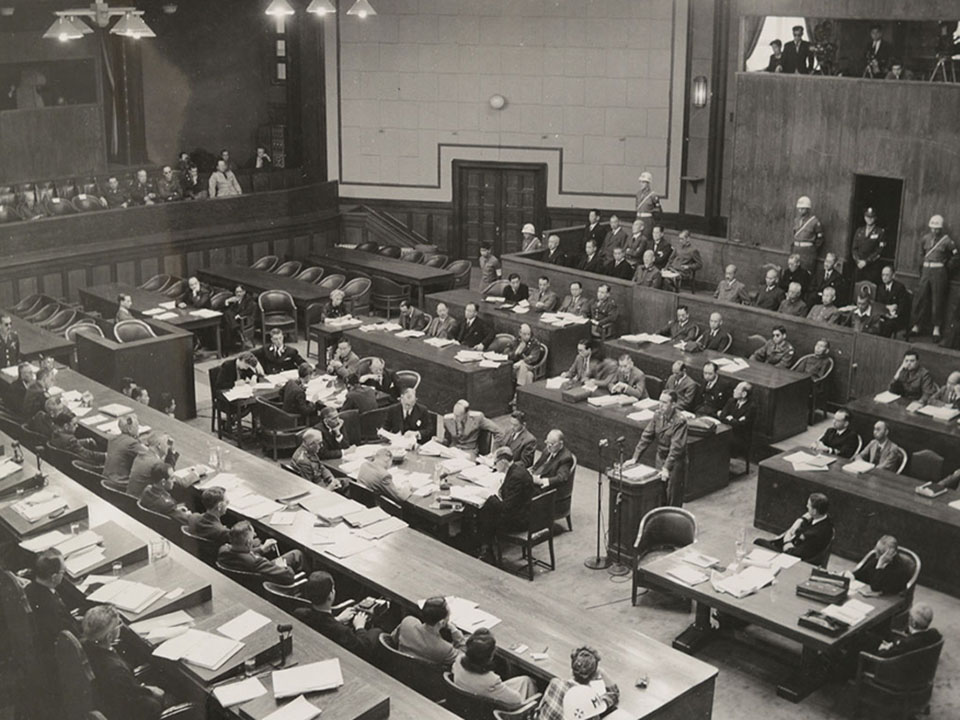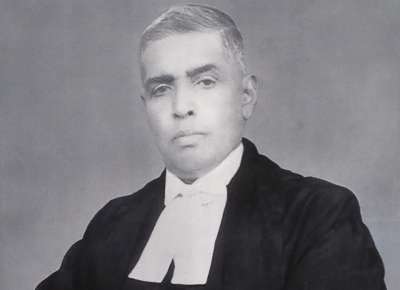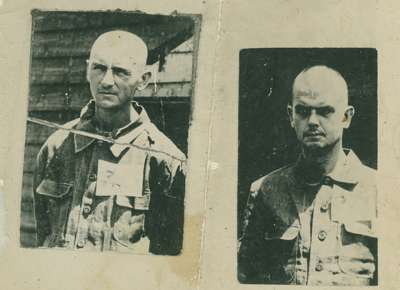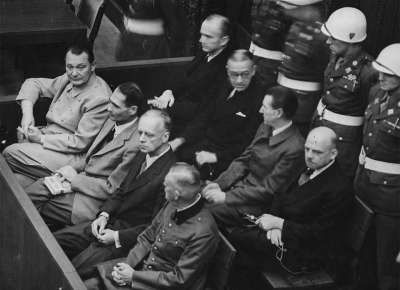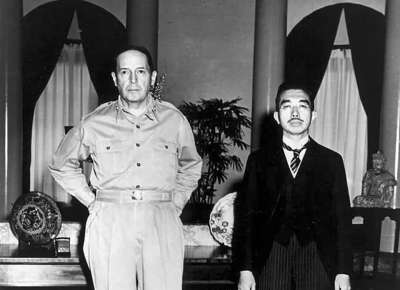OVERVIEW
One week after the surrender of Japan on September 2, 1945, General Douglas MacArthur—the Supreme Commander of the Allied Powers—ordered the arrests of Japanese suspects, including General Hideki Tojo. Twenty-eight defendants, mostly Imperial military officers and government officials, were charged. From May 3, 1946 to November 12, 1948, the trial heard testimony from 419 witnesses and saw 4,336 pieces of evidence, including depositions and affidavits from 779 individuals. Seven defendants were sentenced to death by hanging and 16 defendants were sentenced to life imprisonment.
Appointing the Court
Before the initial arrests in September 1945, one week after the official surrender in Tokyo Bay, there were major disagreements of the terms between Allied administrations about who to put on trial and how to try them. The eleven countries involved were Australia, Canada, China, France, India, the Netherlands, New Zealand, the Philippines, the Soviet Union, the United Kingdom, and the United States. On January 19, 1946, MacArthur ordered the creation of the International Military Tribunal for the Far East (IMTFE) and approved the Charter, with protocols closely imitating the Nuremberg Trials.
On April 25, 1946, the original Rules of Procedure of the International Military Tribunal for the Far East with amendments were announced.
List of Judges
- Justice Harlan F. Stone (United States)
- Justice Myron Cady Cramer (United States)
- Justice John Patrick Higgins (United States)
- Justice Henri Bernard (France)
- Justice Delfin Jaranilla (Philippines)
- Justice Edward Stuart McDougall (Canada)
- Justice Ju-ao Mei (China)
- Justice Erima Harvey Northcroft (New Zealand)
- Justice Radhabinod Pal (India)
- Justice William Donald Patrick (UK)
- Justice Bernard Victor Aloysius Röling (Netherlands)
- Justice William Flood Webb (Australia)
- Justice Ivan Michyevich Zaryanov (Soviet Union)
List of Chief Prosecutors
- Ernest E. Danly (United States)
- Theodore Goulsby (United States)
- Carlisle Wallace Higgins (United States)
- Solis Horwitz (United States)
- Joseph Berry Keenan (United States)
- Luke Lea (United States)
- Edward P. Monaghan (United States)
- Roy L. Morgan (United States)
- Arthur A. Sandusky (United States)
- Frank Stacy Tavenner (United States)
Ichigaya, Tokyo
The trials were held in the former building of the Japanese Ministry of War in Ichigaya, Tokyo. Before World War II, the building housed the Japanese Army Academy where the Japanese advanced the country's military ideologies. During the war, the Imperial General Headquarters made up the Ministry of War, the Army General Staff Office, and the Ministry of the Navy—acting as a center for the direction of war tactics. Over three quarters of Tokyo's buildings were demolished by fires and bombing, but this building was left standing.
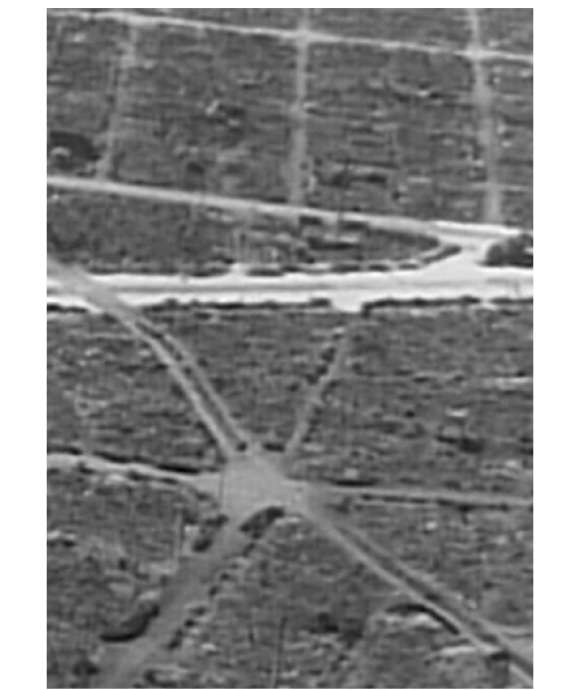
Hellfire on Earth: Operation MEETINGHOUSE
An ominous, deep glow burned crimson on the horizon ahead as the huge silver B-29s streaked low above the surface of the Pacific. The earth burned like a funeral pyre, the flames practically licking the night sky.
The trial was held on the first floor, the second floor was for judges and deliberating, and the third was for the prosecution teams. The office of the Tribunal President, Sir William Flood Webb of Australia, was used by Imperial Japanese Army general and Prime Minister of Japan, Hideki Tojo, during the war.
Indictment
On May 3, 1946, the prosecution opened its case charging the defendants with crimes against peace, conventional war crimes, and crimes against humanity. Like Nuremberg, the Allies established three categories:
Class A: Charges against Japan's top leaders alleging crimes against peace.
Class B and C: Charges at Japanese of any rank covered conventional war crimes and crimes against humanity.
Unlike the Nuremberg trials, the charge of crimes against peace was a prerequisite to prosecution—only those individuals whose crimes included crimes against peace could be prosecuted by the Tribunal. In this event, no Class C charges were heard in Tokyo.
List of Defendants
- Sadao Araki
- Kenji Doihara
- Kingorō Hashimoto
- Shunroku Hata
- Kiichirō Hiranuma
- Kōki Hirota
- Naoki Hoshino
- Seishirō Itagaki
- Okinori Kaya
- Kōichi Kido
- Heitarō Kimura
- Kuniaki Koiso
- Iwane Matsui
- Jirō Minami
- Akira Mutō
- Osami Nagano
- Takasumi Oka
- Shūmei Ōkawa
- Hiroshi Ōshima
- Kenryō Satō
- Mamoru Shigemitsu
- Shigetarō Shimada
- Toshio Shiratori
- Teiichi Suzuki
- Shigenori Tōgō
- Hideki Tōjō
- Yoshijiro Umezu
The Trial
The prosecution had to prove three things: that war crimes were systematic or widespread; the accused knew that troops were committing atrocities; and the accused had power or authority to stop the crimes. Prosecutors presented their case for 192 days finishing on January 27, 1947. A great number of American former POWs provided testimony for the trials.
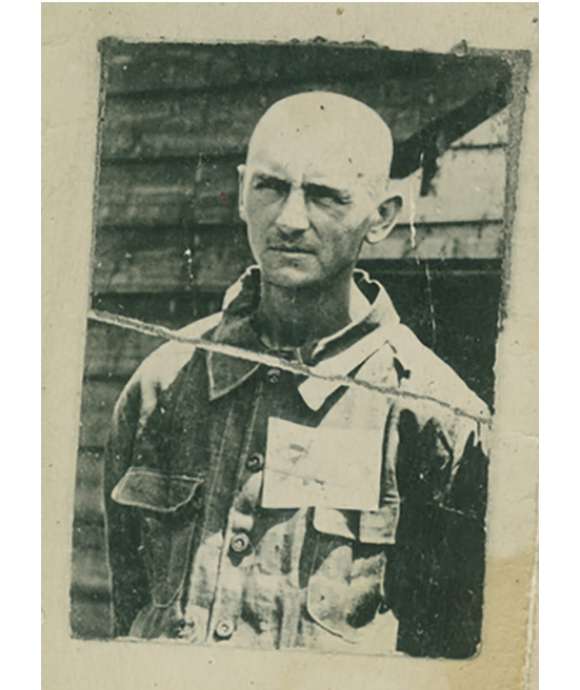
Pacific POW Witness
Crimes related to prisoners of war were a major focus of the trials in the Pacific, but there were many challenges in gathering testimony from the thousands of Allied former POWs who had survived.
The defendants were represented by over a hundred attorneys, 75 percent of them Japanese and 25 percent American. The defense opened its case on January 27, 1947, and finished its presentation 225 days later on September 9, 1947. The main defensive argument was the alleged crimes had yet to be established as international law and Japan's actions were in self-defense.
Verdict and Executions
On September 9, 1947, 15 months and over 1,500 pages of opinion later, judgements were ready to be read. Many judges released opinions outside of the court with a common theme—the absence of Japan's Emperor, Hirohito.
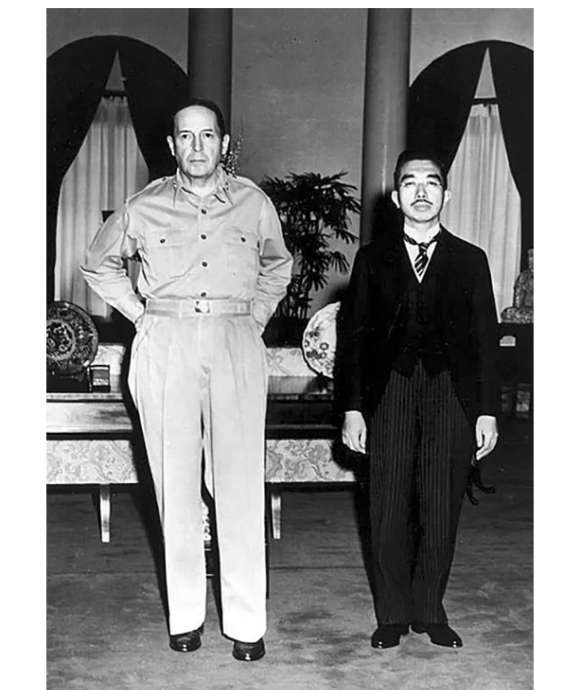
The Fate of Emperor Hirohito
One line of argument about Japan’s surrender maintains the crucial step was a US pledge that Emperor Hirohito could remain on the throne.
Charges were dropped for Shūmei Ōkawa because he was found to be mentally unfit for trial. Two defendants, Yōsuke Matsuoka and Osami Nagano, died of natural causes during the trial. Six defendants were sentenced to death by hanging for war crimes, crimes against humanity, and crimes against peace (Class A, B, and C). One defendant, Iwane Matsui, was sentenced to death for war crimes and crimes against humanity (Class B and C). On December 23, 1948, the defendants were executed at Sugamo Prison with Allied Council as witnesses.
Six defendants were sentenced to life in prison. Koiso, Shiratori, and Umezu died in prison while the other 13 were paroled between 1954 and 1956.
List of Executions
- General Kenji Doihara
- Kōki Hirota
- General Seishirō Itagaki
- General Heitarō Kimura
- Lieutenant General Akira Mutō
- General Hideki Tōjō
List of Prisoners
- General Sadao Araki
- Colonel Kingorō Hashimoto
- Field Marshal Shunroku Hata
- Baron Kiichirō Hiranuma]
- Naoki Hoshino
- Okinori Kaya
- Marquis Kōichi Kido
- General Kuniaki Koiso
- General Jirō Minami
- Admiral Takazumi Oka
- Lieutenant General Hiroshi Ōshima
- General Kenryō Satō
- Admiral Shigetarō Shimada
- Toshio Shiratori
- Lieutenant General Teiichi Suzuk
- General Yoshijirō Umezu
- Foreign minister Shigenori Tōgō
- Foreign minister Mamoru Shigemitsu
Subsequent Tokyo Trials
Australia, China, France , the Netherlands Indies, the Philippines, the United Kingdom, and the United States convened separate trials convicting more than 5,500 more lower ranking war criminals. The trials were held all over Asia and the Pacific and the last one was in 1951. China held 13 tribunals, resulting in 504 convictions and 149 executions. The total number of death sentences are as follows:
United States - 140
The Netherlands - 236
United Kingdom - 223
Australia - 153
China - 149
France - 26
Philippines - 17
